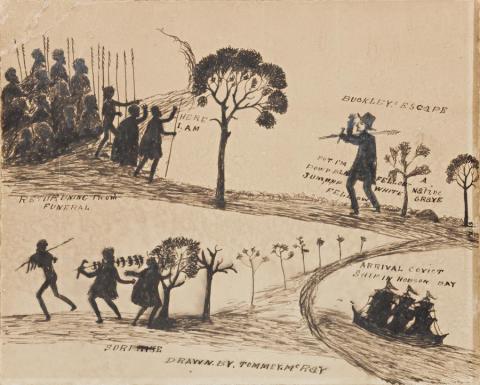BUCKLEY'S ESCAPE, 1890s
TOMMY McRAE
pen and ink on paper
24.0 x 30.0 cm
inscribed throughout composition: RETURNING FROM / FUNERAL; HERE / I AM; BUCKLEY’S ESCAPE; PUT I’M / DOWN BLA[CK] FELLOW / JUMP UP WHITE / FELLOW; A / Native / GRAVE; ARRIVAL COVICT / SHIP IN HOBSON BAY; SURPRISE; DRAWN.BY.TOMMEY.McRAY
Collected in the 1890s by the current owner's great-grandfather, Corowa region, New South Wales
Thence by descent
Private collection, New South Wales
Sayers, A., Aboriginal Artists of the Nineteenth Century, Oxford University Press, Melbourne, in association with the National Gallery of Australia, Canberra, 1994, pp. 40–41 and 129, cat. M28
A group of Aborigines holding spears, and a single European man wearing a suit and hat, pen and ink, 25.0 x 31.5 cm, in Book of Sketches of Aboriginal Life by Tommy McRae, collection of the State Library of Victoria, Melbourne
Buckley meeting a group of Aborigines, Private collection, Canberra, cat. M30; Ceremony with Buckley and sailing-ship, Koorie Heritage Trust, Victoria, cat. M9; and Buckley meeting a group of Aborigines, Private collection, Canberra, cat. M31, illus. in Sayers, A., Aboriginal Artists of the Nineteenth Century, Oxford University Press, Melbourne, in association with the National Gallery of Australia, Canberra, 1994, pp. 39–39
Buckley's Escape (lot 7) and Murray Tribe Warfare (lot 8), two pen and ink drawings by Kwatkwat artist Tommy McRae were purchased from the artist in the 1890s by Mr. John Guthrie-Gray, a Scottish émigré and landholder in the Corowa district. McRae was one of only a few Aboriginal artists who produced drawings of 19th century Australia, the surviving images providing a unique and rare insight into the tumultuous settlement decades.
Born in 1835, McRae spent most of his life in the upper reaches of the Murray River along the New South Wales and Victorian border. Along with William Barak, he was one of the best known Aboriginal artists working at that time. Also known as Yakaduna, Tommy Barns and Thommy McRae, his preferred medium was drawing, usually pen and ink on paper. His drawings executed primarily in sketchbooks, sometimes on loose sheets, observed aspects of traditional Aboriginal life and early colonial settlement. The drawings produced by McRae were made at a time when life around him was changing dramatically and at pace. His later years were spent in the Corowa- Wahgunya area at the Aboriginal reserve established at Lake Moodemere where McRae set up a family camp. It was there that the majority of his drawings were produced.
The earliest documented collection of his drawings date from the early 1860s at which time the artist was described as working as a stockman for pastoralists in the upper Murray region and his sketchbooks include drawings of pastoralists and their homesteads. McRae possessed an extensive knowledge of the traditional lifestyle of his people as evidenced in his drawings of the often repeated themes of hunting, fishing, warfare and ceremonial dances. His drawings are described by Andrew Sayers as 'distinctive in the use of the silhouette. It is an art of extreme economy but for all its reductiveness... is highly expressive'.1
The subject of William Buckley, the escaped convict who was accepted into the Wathurung clan with whom he lived for 32 years during the early 1800s, held particular interest for McRae. Whereas most of McRae's subjects were broadly descriptive, his depictions of the Buckley story record (at a distance) a specific historical event that was coming to its conclusion the year McRae was born.
The story of Buckley known as the 'Wild White Man' achieved mythical status in the burgeoning white settlement of Victoria and was discussed in books, pamphlets and newspaper reports throughout the century. Having been transported to the colonies for life, Buckley absconded from the sailing vessel Calcutta when it anchored at Port Philip. An account of his first meeting with local people describes how Buckley, after struggling for a time in the bush without food or water, came across a native grave. Commandeering a spear that was protruding from the grave site to use as a walking stick, Buckley soon encountered local people, who believed him to be the re-incarnation of the owner of the spear and readily accepted him into their community. Buckley subsequently learnt the language and customs, actively participating in aboriginal life for three decades before giving himself up to a party of European surveyors in 1835.
Buckley's Escape is the first work detailing the William Buckley story to appear at auction though the subject matter is one McRae has addressed in other works. This particular example is even more significant because it depicts multiple episodes from the Buckley story. Noted in Sayers as providing a more elaborate narrative, the different parts of the composition provide a more complete story of the Buckley legend.2
As Carol Cooper concludes in her monograph Aboriginal History, Tommy McRae was 'a gifted man with extraordinary talent who, in spite of a lifetime of great hardship which saw the destruction of his people and the separation of his family, maintained a sense of dignity and ironic humour which won the admiration of all who knew him, Aborigines and Europeans alike'.3
1. Sayers, Andrew, Aboriginal Artists of the Nineteenth Century, Oxford University Press, Melbourne, 1994 p. 29
2. Sayers, Andrew, Aboriginal Artists of the Nineteenth Century, Oxford University Press, Melbourne, 1994 p. 40
3. Copper, Carol and Urry, James, Art, Aborigines and Chinese: A Nineteenth Century Drawing by the Kwatkwat Artist Tommy McRae, in Aboriginal History, Vol 5, 1981 p. 88
